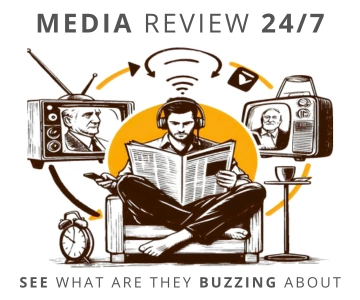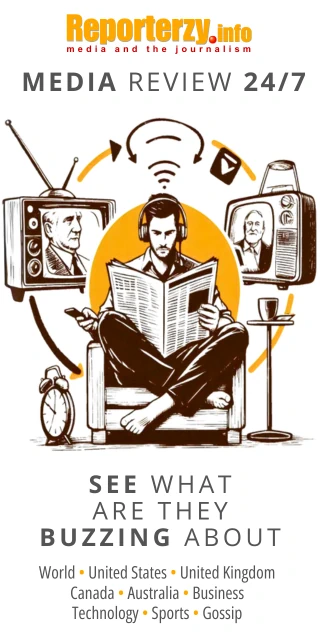 illustration: Bing AI
illustration: Bing AITrust in journalism in 2025 has reached a historic low – only 41% of surveyed media leaders expressed optimism about the industry`s future. This marks a 19 percentage point drop compared to 2022. Key challenges identified by respondents include political attacks, societal polarization, and the growing dominance of alternative media ecosystems.
The declining popularity of traditional media in favor of content created by influencers and media personalities has been ongoing for years. This trend is particularly visible among audiences under 30, where 37% regularly consume news published by online creators. This shift has serious implications for how society perceives the credibility of information. Simultaneously, traditional media, instead of competing, increasingly collaborates with influencers to reach younger audiences.
The Battle for Visibility in the Age of AI
The integration of artificial intelligence into search systems is reshaping the media landscape. According to the report “Journalism, Media, and Technology Trends and Predictions 2025,” 74% of publishers are concerned about losing search traffic, especially as AI generates news summaries, reducing clicks to source websites.
Google Discover, while growing as a traffic source (+12%), does not compensate for losses from other platforms, such as Facebook (-67% traffic over two years) or Twitter (-50%). Publishers also face new players like ChatGPT Search and Perplexity, which introduce revenue-sharing models favorable to select publishers but exclude smaller newsrooms.
- Example of technology impact: ChatGPT Search, launched in late 2024, delivers licensed content from reputable publishers like News Corp. Publishers signing such agreements receive preferential treatment, helping them maintain website traffic.
New Business Models: Opportunities and Risks
Subscription revenue remains the primary pillar of media funding – 77% of publishers identify it as a significant income source. However, subscriber growth is slowing, forcing publishers to explore new solutions. The report shows that publishers increasingly turn to diversified revenue streams such as events, partnerships with AI platforms, and donations.
| Revenue Source | Percentage of Publishers Considering Important |
|---|---|
| Subscriptions | 77% |
| Display Advertising | 69% |
| Events | 48% |
| AI Platforms | 36% |
| Donations | 19% |
Many publishers are investing in innovative products like audio apps, games, or educational platforms. An example is The Guardian`s culinary app “Feast,” which attracts new audiences by offering specialized content within a subscription model.
Changing Relationships with Platforms
Relationships between publishers and tech giants like Google, Apple, or OpenAI are becoming increasingly complex. 31% of respondents plan to strengthen collaboration with AI platforms, while a similar percentage seeks to limit such partnerships to reduce dependency on external partners.
- Platforms in focus:
- YouTube and TikTok (+52 and +48 net points in publisher evaluations) are identified as channels of growing importance.
- Meanwhile, Facebook (-42) and X (Twitter) (-68) are losing significance among publishers, prompting investments in alternative distribution channels.
The Role of Personalities and Influencers
Internet creators are increasingly competing with traditional media. In the US, 21% of respondents report regularly consuming news from influencers. In Europe, young creators like Hugo Travers in France or Jordan Shanks in Australia attract millions of followers with their authentic approach.
However, concerns about content quality are rising – according to UNESCO, 62% of influencers do not verify information before publication. Nonetheless, many newsrooms see this as an opportunity to collaborate and reach new audience groups.
The full report "Journalism, Media, and Technology Trends and Predictions 2025" can be read on the Reuters Institute website.
COMMERCIAL BREAK
New articles in section Media industry
Most medical influencer posts on TikTok are FALSE
KFi
Researchers from East Carolina University Health Medical Center analysed 120 TikTok videos tagged with hashtags such as #naturalparenting, #antivaccine, and #holistichealth. The results of their study leave no doubt.
Dead internet theory is a fact. Bots now outnumber people online
Krzysztof Fiedorek
Already 51% of global internet traffic is generated by bots, not people. As many as two-thirds of accounts on X are likely bots, and on review platforms, three out of ten reviews weren't written by a human. Do you feel something is off online? It's not paranoia. In 2025, it's a reality.
The most valuable female personal brands in Polish fashion. IMM report
KFi
The ten most popular people in Poland in the "fashion" category generate over 1.5 billion contacts across all types of media in a year. Their value is nearly 400 million zlotys. The ranking was prepared by the Institute of Media Monitoring for "Forbes Women" magazine.
See articles on a similar topic:
New Technologies in Journalism. PressInstitute Study
BARD
Nearly 39% of journalists use their smartphone or tablet camera to record videos, while over 26% use the built-in camera to take photos that they later publish, according to the "Journalists and New Technologies" study by PressInstitute.
Read digital newspapers and magazines in PDF, EPUB and MOBI [LINK]
AUTOPROMOCJA Reporterzy.info
The most popular daily, weekly, biweekly and monthly magazines in electronic PDF, EPUB and MOBI formats. For reading on a computer, smartphone and e-reader. The latest issues, archive issues and subscriptions are just a few clicks away. Visit our Reporterzy.info Store
Clickbait Uncovered. How Online Headlines Evolved Over 25 Years
Krzysztof Fiedorek
Researchers from the Max Planck Institute analyzed 40 million headlines from the past 25 years. They are getting longer, more emotional, and negative, with a clear influence of clickbait style. Even reputable media use strategies and tricks to grab attention.
Influencers and social video rule information. Digital News Report 2025
Krzysztof Fiedorek
Seconds of vertical clips set the future of news. TikTok, YouTube and an army of influencers pull viewers away from TV sets and newspaper pages. Whoever masters this new pulse seizes not only attention but also control of the story.






























